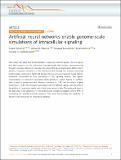Artificial neural networks enable genome-scale simulations of intracellular signaling
Author(s)
Nilsson, Avlant; Peters, Joshua M; Meimetis, Nikolaos; Bryson, Bryan; Lauffenburger, Douglas A
DownloadPublished version (4.156Mb)
Publisher with Creative Commons License
Publisher with Creative Commons License
Creative Commons Attribution
Terms of use
Metadata
Show full item recordAbstract
<jats:title>Abstract</jats:title><jats:p>Mammalian cells adapt their functional state in response to external signals in form of ligands that bind receptors on the cell-surface. Mechanistically, this involves signal-processing through a complex network of molecular interactions that govern transcription factor activity patterns. Computer simulations of the information flow through this network could help predict cellular responses in health and disease. Here we develop a recurrent neural network framework constrained by prior knowledge of the signaling network with ligand-concentrations as input and transcription factor-activity as output. Applied to synthetic data, it predicts unseen test-data (Pearson correlation <jats:italic>r</jats:italic> = 0.98) and the effects of gene knockouts (<jats:italic>r</jats:italic> = 0.8). We stimulate macrophages with 59 different ligands, with and without the addition of lipopolysaccharide, and collect transcriptomics data. The framework predicts this data under cross-validation (<jats:italic>r</jats:italic> = 0.8) and knockout simulations suggest a role for RIPK1 in modulating the lipopolysaccharide response. This work demonstrates the feasibility of genome-scale simulations of intracellular signaling.</jats:p>
Date issued
2022Department
Massachusetts Institute of Technology. Department of Biological EngineeringJournal
Nature Communications
Publisher
Springer Science and Business Media LLC
Citation
Nilsson, Avlant, Peters, Joshua M, Meimetis, Nikolaos, Bryson, Bryan and Lauffenburger, Douglas A. 2022. "Artificial neural networks enable genome-scale simulations of intracellular signaling." Nature Communications, 13 (1).
Version: Final published version